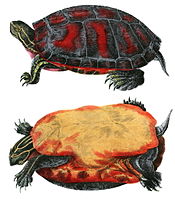
The brown roofed turtle is a species of turtle in the family Geoemydidae. The species is endemic to South Asia. Two subspecies are recognized.

Sternotherus is a genus of turtles in the family Kinosternidae including six species commonly known as musk turtles. The genus is endemic to North America, occurring in the eastern third of the US and southeast Ontario, Canada. Musk glands positioned near the bridge of the shell can produce foul smelling secretions when the turtles are threatened, although gentle handling does not normally provoke a response. Sternotherus are moderately small turtles, with the largest species in the genus, the razor-backed musk turtle, attaining a maximum of 17.6 cm. in shell length. The carapace is characteristically oval and domed, with most species having one or three keels on the back which may become smoother and obscure with age in some species. Musk turtles are generally drab in color, mostly black, gray, brown, olive, or ocher, which aid in camouflaging them in their natural habitats. The head is relatively large and stout, marked with spots, streaks, or strips. The plastron has only 10 or 11 scutes, as opposed to 12, a more common condition in North American turtles. The tail is short, with males having a horny claw like tip.

The razor-backed musk turtle is a species of turtle in the family Kinosternidae. The species is native to the southern United States. There are no subspecies that are recognized as being valid.
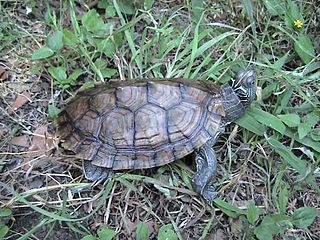
Graptemys is a genus of freshwater turtles containing 14 species, commonly known as map turtles. Graptemys are small to medium-sized turtles that are significantly sexually dimorphic, with females in some species attaining as much as twice the length and ten times the mass as males. Depending on the species, adult males range from 7–16 cm (2.75–6.25 in), adult females 10–29.5 cm (4–11.62 in), and hatchlings 2.5–3.8 cm (1–1.5 in), although some sources indicate female Barbour's map turtles grow to 33 cm (13 in) in length. Most species have a distinctive dark pigmented keel that is often notched or serrated running down the center of the carapace and serrated scutes on the rear margin. The head, neck, and limbs exhibit bold patterns of yellow lines and spots against darker green, olive, or black base colors. The patterns on the head can be important characters in identifying the various species. The common name "map turtle" is derived from the intricate patterns on their shells that are suggestive of topographical maps, although the patterns are more apparent in some species than others, and often become obscure in older specimens. Some species are occasionally called "sawbacks", in reference to the serrated keels on their shell.

The Big Bend slider, also called commonly the Mexican Plateau slider and la jicotea de la meseta mexicana in Mexican Spanish, is a species of aquatic turtle in the family Emydidae. The species is native to the Southwestern United States and northern Mexico.
The Caspian turtle, also known as the striped-neck terrapin, is a species of turtle in the family Geoemydidae (=Bataguridae). It is found in west Asia, in Iran and central Turkey, northward to the Republic of Georgia and eastward to southwestern Turkmenistan, and in Iraq, Saudi Arabia, and Bahrain.

The Cumberland slider, also called commonly the Cumberland turtle and Troost's turtle, is a subspecies of pond slider, a semiaquatic turtle in the family Emydidae. The subspecies is indigenous to the Southeastern United States.

Barbour's map turtle is a species of turtle in the family Emydidae. The species is native to the southeastern United States.
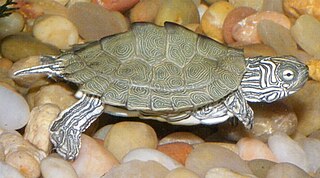
Cagle's map turtle is a species of turtle in the family Emydidae. The species is endemic to Texas, where it is native to the Guadalupe, San Antonio, and San Marcos Rivers.

The Escambia map turtle, also known commonly as Ernst's map turtle, is a species of turtle in the family Emydidae. The species is endemic to the United States.

The yellow-blotched map turtle, or yellow-blotched sawback, is a species of turtle in the family Emydidae. It is part of the narrow-headed group of map turtles, and is endemic to the southern United States.

The black-knobbed map turtle, formerly known as the black-knobbed sawback, is a small to medium-sized aquatic turtle with light gray skin. Some of the most distinguishing characteristics of the black-knobbed map turtle, and the Graptemys genus, are the protruding "spikes" on the turtle's carapace. This species inhabits mainly the fall lines of rivers in the Mobile Bay drainage, in Alabama and Mississippi.

The ringed map turtle or ringed sawback is a species of turtle in the family Emydidae endemic to the southern United States.

The northern map turtle, also known as the common map turtle, is an aquatic turtle in the family Emydidae. It is endemic to North America.
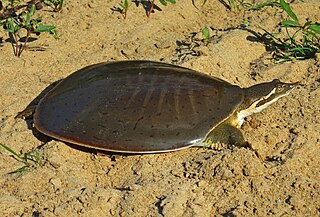
The smooth softshell turtle is a species of softshell turtle of the family Trionychidae. This freshwater turtle is endemic to the United States where it inhabits the Mississippi River system and other river basins emptying into the Gulf of Mexico.

The Mississippi map turtle is a subspecies of land and water turtle belonging to the family Emydidae. G. p. kohni is endemic to the central United States.

The false map turtle is a species of turtle endemic to the United States. It is a common pet species. Two subspecies are recognized, including the nominotypical subspecies described here.
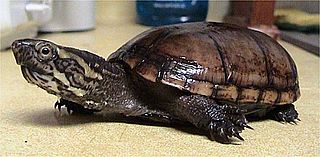
The eastern mud turtle or common mud turtle is a common species of turtle in the family Kinosternidae. The species is endemic to the United States. There are two recognized subspecies.
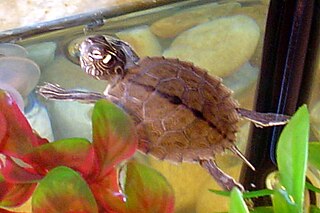
The Ouachita map turtle is a species of turtle belonging to the family Emydidae.
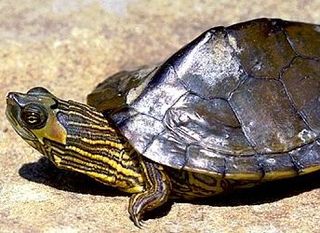
The Alabama map turtle is a species of emydid turtle endemic to the southern United States. Differentiation from other turtle species includes a black stripe running down the center of its back with knobs extruding from it, but these projections wear down with age. T.H. Bean and L. Kumlen first collected the Alabama map turtle in July 1876 from a lake near Montgomery, Alabama. Type locality for this species is Montgomery County, Alabama. Baur described and named the Alabama map turtle in 1893. The genus Graptemys includes nine species of mostly aquatic turtles.






















